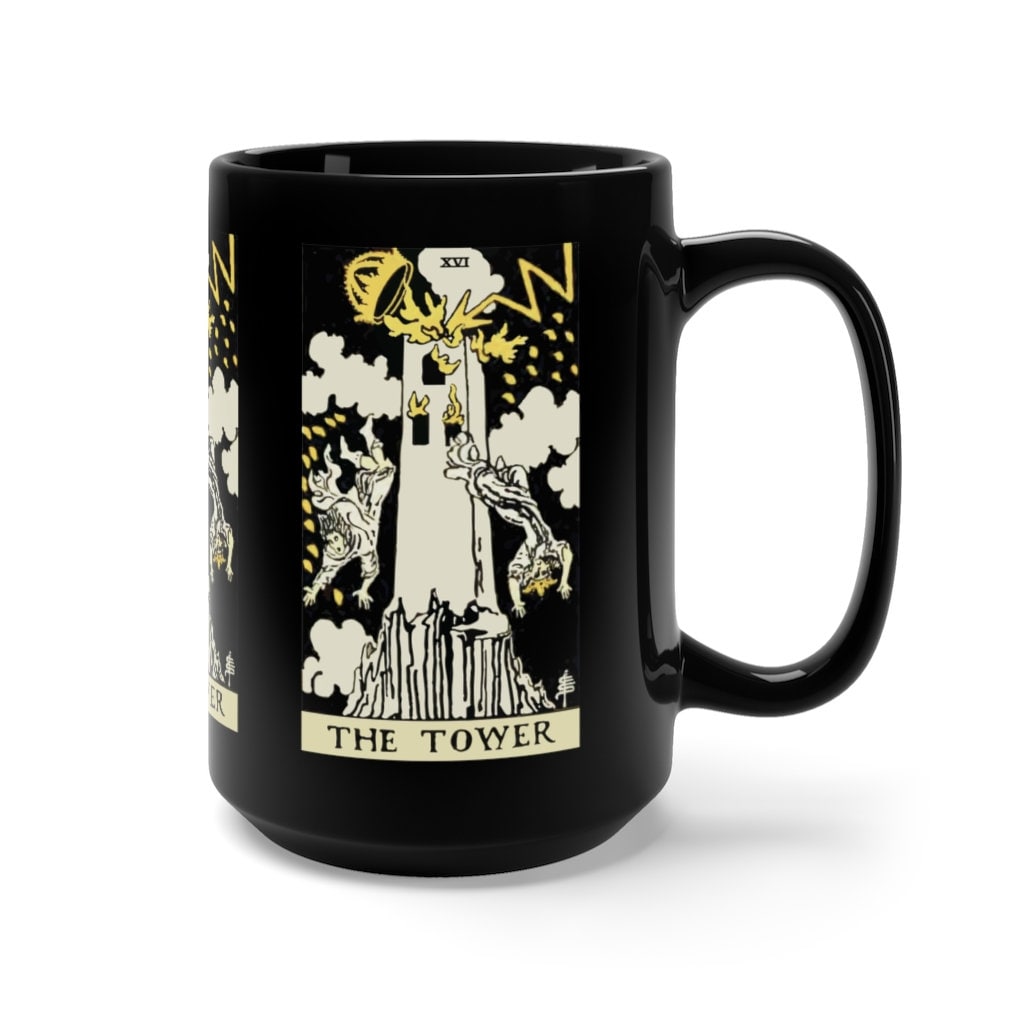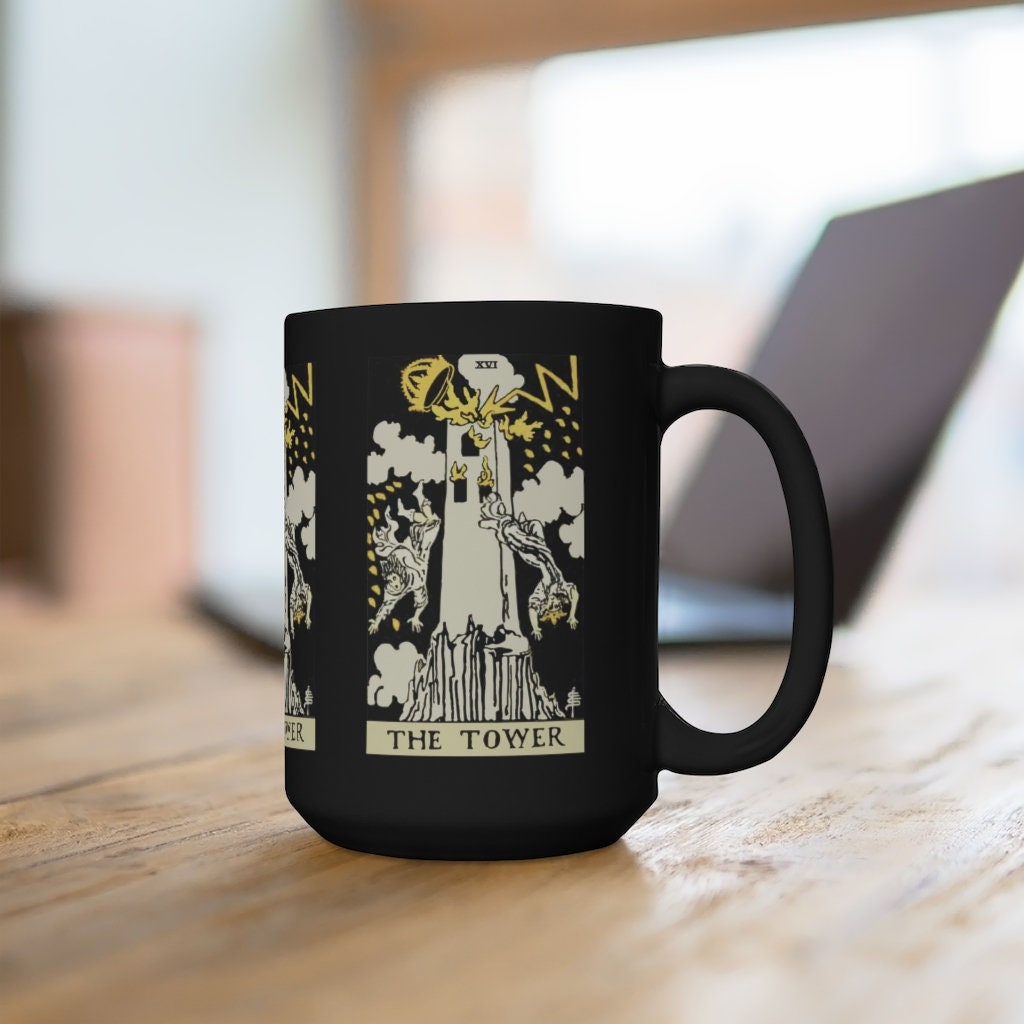The Tower, Black 15oz Ceramic Mug, Tarot Card, Major Arcana, From Vintage Rider-Waite Deck, Coffee, Tea
$23.00
More tarot card items: https://www.vintageartwork.com/search?q=tarot+card
Design is a major arcana tarot card, "The Tower", from an early 20th century version of the Rider-Waite Tarot deck.
The Tower (Upright):
The Tower card in Tarot is often associated with sudden change, upheaval, and chaos. It signifies unexpected events that may seem destructive at first but are often necessary for growth and transformation.
Symbolism: The image on the card often depicts a tall tower struck by lightning, with people falling out of it. The lightning represents a sudden shock or realization, the falling people signify being thrown out of one's comfort zone, and the tower itself can be seen as a structure or belief system that is no longer serving a person.
Meaning: The Tower card warns that something in your life needs to change, whether you're ready for it or not. This might be a dramatic revelation, the crumbling of a belief system, or the end of a situation or relationship. While the immediate aftermath might feel chaotic, the Tower ultimately encourages you to see this period as an opportunity for growth and renewal.
The Tower (Reversed):
When the Tower card is reversed, it can have a slightly different or nuanced interpretation:
Avoidance of disaster: It can signify that you've managed to avoid or avert a major crisis or that its effects won't be as severe as expected.
Internal upheaval: The reversed Tower might also indicate a personal, internal disruption rather than an external one. This could be a major shift in perspective or a realization about oneself.
Fear of change: In some contexts, it could represent a fear of the upheaval that change can bring, and a resistance to let go of outdated beliefs or situations.
Delay: Sometimes, it suggests that the inevitable breakdown or change is delayed, but still looming.
Never run out of your favorite hot drink! Bigger size durable ceramic mug in always fashionable black color. High quality sublimation printing makes it an appreciated gift to every true coffee or tea lover, who always asks for a refill.
.: Black ceramic
.: 15 oz (0.44 l)
.: Rounded corners
.: C-handle
.: Size: Large. This mug is 36% larger than a standard size mug, which is 11oz (0.33 l). Another way to look at it is that a standard mug is only 73% of this mug's size.
Safe and Secure Biodegradable Packaging:
This mug is packaged in a cardboard box with a crash-lock base and inner fitting inserts. This high quality packaging provides extra protection for safe transportation.
Shipping from United States
Processing time
1-7 business days
Customs and import taxes
Buyers are responsible for any customs and import taxes that may apply. I'm not responsible for delays due to customs.
Payment Options
Returns & Exchanges
I gladly accept returns and exchanges
Just contact me within: 14 days of delivery
Ship items back to me within: 30 days of delivery
I don't accept cancellations
But please contact me if you have any problems with your order.
The following items can't be returned or exchanged
Because of the nature of these items, unless they arrive damaged or defective, I can't accept returns for:
- Custom or personalized orders
- Perishable products (like food or flowers)
- Digital downloads
- Intimate items (for health/hygiene reasons)
Conditions of return
Buyers are responsible for return shipping costs. If the item is not returned in its original condition, the buyer is responsible for any loss in value.
Frequently Asked Questions
What is All-Over-Print (AOP)?
All-Over Print (AOP) is a printing method that uses dye-sublimation to print a design onto polyester. During the dye sublimation process the dye is absorbed into the fabric. Since, it is not printed on the surface, like most t-shirts, it provides for a fantastic soft-to-the-touch feel and superior breathability.
AOP is a more time consuming method than screen printing or direct-to-garment (DTG) printing, so the prices are higher and the production times are longer, but the results are most definitely worth it.
Advantages of AOP:
The design won't peel off, unlike typical screen printing.
The design is part of the fabric of the item, so it will last as long as the item does.
The intensity of color is often unmatched.
What is Giclée?
Giclée (pronounced zhee-CLAY or often gee-CLAY) is a printing process that creates a museum quality, archival print. Special acid-free, paper is printed with fade resistant ink using a state-of-the-art, large format inkjet printer.
What is a gallery wrap canvas?
Gallery wrap is a style of displaying a canvas that doesn't show any visible staples or nails holding the fabric to the wooden stretcher bars. This style of canvas is intended to be hung unframed.
What is a gallery mirror wrap canvas?
Mirrored edges (mirror wrap) is used to show the whole image on the main surface, rather than printing the edges of the image on the sides (image wrap) of the canvas frame. It is usually used when there is necessary detail on the edges of the image. Image wrap is used when the focal point of the image is in the center.




